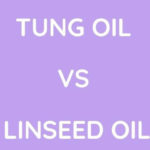What if you are a woodworker looking to finish your project? What will be your choice? Danish or Tung oil? What if you are a novice user and have no idea about both? Well, let’s make it easy for you. Here, we have compared Danish Oil vs Tung Oil for you.
Contents
Our Verdict
To choose the best one among these two is different. If you need excellent protection and do not want to put in too much effort, Danish oil is for you. Danish oil is the winner. It dries faster, easy to use. It leaves a satin finish, and you can use it on any wood surface. It has excellent penetration power and excellent water resistance.
But if you a hardcore fan of the perfect golden finish offered by tung oil, then choose that. It is hard to apply, dries slower, and needs many coats. It is food safe and adds to the appeal a lot. It offers better protection to the wood. But the time and effort make it less appealing. Also, the finish makes you wonder it is worth it. Often it is worth it.
Danish Oil Vs Tung Oil: Comparison Chart
| Specification | Danish Oil | Tung Oil |
|---|---|---|
| Appearance | Satin Finish | Hard, Glossy Finish |
| Type of Wood | All | All |
| Number of coats needed | 3 | Six or more |
| Drying time | 4-8hrs | 8-24hrs |
| Penetration | Very Good | Poor |
| Water resistance | Good | excellent |
| Food Safety | No | Yes |
| Maintenance | Occasional | Regular |
| Yellowing | No | Possible |
Danish Oil Vs Tung Oil: Differences
1. Finish
Danish oil provides a water-resistant satin finish. It is a hard-wearing, long oil finish. It does not add any color to the wood while penetrating the wood. It keeps the wood texture as such it is. Over the years also it does not fade. This often gives a far better appeal to buys who do not want regular maintenance. Tung oil provides a challenging, clear, in-depth look at your woodwork. It gives a waterproof coat over the surface. But that advantage is overshadowed by the need for regular maintenance. Also, it needs a longer drying time.
Bottom Line: Tung Oil Wins
2. Number Of Coats Needed
Danish oil is easy to apply, and it only needs up to 3 coats. This is a considerable difference as Tung oil needs six or more. Twice than that of Danish oil. The time required for tung oil to dry is very high too. It takes more than 8hrs for the 1st coat of tung oil to dry. That can be pretty difficult.
Bottom Line: Danish Oil Wins
3. Drying Time
The average drying time for a coat of Danish oil over a wood surface is 4hrs. But, the average drying time for tung oil is more than 8hrs. For a smooth, even finish on both, you need to apply many coats. In Danish oil, it needs at least three coats, which equates to 12 hrs. For Tung oil, the number of coats is 6. The time required to dry will be 2 to 3 days. Based on the thickness drying time can go up.
Bottom Line: Danish Oil Wins
4. Penetration
Danish oil has good penetration properties. It can penetrate hardwood such as mahogany, maple, cherry, oak, and ironwood. But Tung oil is not a good penetrator. Its penetration power is poor. Even for easy usage and minimal penetration, you need to add thinner and use it.
Bottom Line: Danish Oil Wins
5. Food Safety: Tung Oil Wins
Danish oil cures by polymerization. Over the years, various studies revealed that Danish oil is safe. But, in the absence of proper curing, it can be hazardous. It is dangerous, and appropriate curing has to be ensured. Tung oil is food safe.
Bottom Line: Tung Oil Wins
Danish Oil Vs Tung Oil: Similarities
1. Water Resistance
Both Danish and Tung oil provides excellent protection for the wood. Both forms a water repellent coat over the wood surface. For the wood, water can be damaging. Danish oil and Tug oil include a transparent or translucent coat over the surface. The polymerized product is water impermeable.
2. Type Of Wood
You can use both Danish and Tung oil on all types of wood. Both offer an excellent level of finish and protection for the wood.
3. Application Procedure
The application procedure for both is also the same. You will need to sand the wood surface. After sanding, clean it, removing all the dust. After that, apply a single coat of Danish or Tung Oil and let it dry. After drying, apply the next coat. Continue till you get the required finish.
Danish Oil Vs Tung Oil: Chemical Composition
The chemical composition of Danish oil and Tung oil is different. Tung oil consists of 100% tung oil. But Danish oil differs in composition.
1. Danish Oil
Danish oil is a blend of different oils, resin, and varnish. Some amateur woodworkers created Danish oil. They mixed mineral spirits and varnish with linseed oil. This made the linseed oil thinner and easy to apply. This was taken advantage of by manufacturers and business people. They started producing ready-made formulation of the same. Many manufacturers have Danish oil, and each one differs in composition, thickness, etc.
2. Tung Oil
Tung oil is produced from the nut of the tung tree. The tree is most common in China. In its pure form, Tung oil is a thick liquid. You can use it with or without thinning.
Danish Oil Vs Tung Oil: How To Apply?
Both Tung oil and Danish oil have similar application procedures. 1st sand and polish the wood. To ensure a smoother finish, sand up to 32p grit at least. After then, clean and buff the surface. Make sure no residues or dust there on the surface. Clean and wipe the surface with mineral solvent. After that, apply the 1st coat and leave it to dry. After drying, apply the next coat. Continue the procedure until you get the required finish. After getting the required finish clean the surface.
While applying the coats, ensure that it is even and uniform. If it is uneven, sand it down and make it even. In the case of Tung oil, you will have to sand the surface after each coat to ensure a better finish. Also, to avoid excessive application of the oil, wipe it down 30 minutes after applying it. This helps to produce an even smooth finish.
Danish Oil Vs Tung Oil: Overview
Overview Of Danish Oil
Danish oil is a wood finishing oil. You can make it by mixing linseed or tung oil (see comparison of both) with mineral spirits and varnish. Or you can buy a prepared mix from any manufacturers. Each manufacturer’s composition and thickness can vary. This is because there exists no perfect formula for Danish oil. Danish oil provides a smooth satin finish over the wood.
It can penetrate the wood to enhance protection. Danish oil can penetrate even hardwood like ironwood, mahogany, etc. Danish oil can dry faster and need only three coats. Often 1 or 2 coats of Danish oil is more than enough. The average drying time for Danish oil is 4hrs. Hence, it is to use and apply again. You don’t have to wait for a long time to apply for the second or third coat.
The protection offers to the wood is also great. It protects the wood from water. But the water-repelling capabilities are not stellar. Yet it does the job and protects the wood. On the plus side, it does not need much maintenance. Danish oil can penetrate the wood also. These two features make it the 1st choice for many woodworkers.
Danish oil often maintains a clear, transparent finish over time. It will not yellow. Also, you can mix unique pigments or tan to produce the desired look for the finished wood. You can also apply it over polyurethane, which is handy. Furthermore, Danish oil can act as a wood primer if the need arises. But Danish oil is often considered as not food safe.
Danish oil cures by polymerization while the coat reacts with air. The Danish oil reacts with oxygen to form the surface coat. If the curing process is not complete, then it can leave hazardous compounds on the surface. This makes them a severe health hazard. But, if the curing process is complete and ok, then it is safe.
You can buy Danish oil from different manufacturers. Here are some:
- Deft Danish Oil
- General Finishes’ Sealacell
- Behlen Danish Oil
- Maloof Finish
- Behr Scandinavian Tung Oil Finish
- Minwax Tung Oil Finish
- Minwax Antique Oil Finish
- Velvet Oil
- Watco Danish Oil
- Fast drying
- Easy to apply
- Easy to repair
- Good penetration
- Waterproof
- Satin finish
- A clear, transparent coat
- Long-lasting
- No yellowing over time
- It can act as a primer.
- Less durable
- Not food safe
- Volatile compounds can burn
- Disposal of cleaning cloth after wiping with mineral oils
Overview Of Tung Oil
Tung is produced from the seed of the tung tree. The tree is most common in China. Tung oil offers a transparent, deep, and golden look. You by them as 100% oil and often has to thin it to use it. The significant advantages of tung oil are water-resistant properties, food safety, looks, etc. They offer excellent water resistance. They were used by the Chinese in ships decades ago. Tung oil often creates a hard surface upon drying.
The coat, even though challenging, is also elastic. This is a cool feature as it can expand and contract along with wood. The wood expands and contracts when exposed to heat and cold. Tung oil on such occasions can keep a good lookup. This is great. It offers an excellent finish. It provides a transparent golden finish. You can apply it to any type of wood. Making it ideal for any woodworkers. It polymerizes both inside and outside the wood. This helps to protect the wood from scratches, dents, and acids. It is also food-safe, which is excellent.
It is a non-toxic, natural product hence safe to use with kitchen equipment. But it has many advantages. It needs a lot of time to dry. The average time for drying a single coat takes anywhere from 8 to 24hrs. Also, you need to apply more than six coats to ensure proper penetration.
Being 100% oil, the penetration capacity very low. Also, storing 100% tung oil can be difficult. Protection from heat and light is a must. Exposure to both can get it ruined. It is often difficult to find 100% pure Tung oil. Most of the time, they are Danish or any other oil like linseed or teak oil. Sometimes they are thinned versions of Tung oil. Getting a pure 100% version is always difficult.
- Waterproof
- Lovely appearance
- Food Safe
- Elasticity
- Strong Protective Surface
- Doesn’t produce a matte-like finish
- Plenty of work involved
- Long Curing
- Storage difficulties
- Number of coats
- Poor penetration power
- Regular maintenance
- Difficulty in getting 100% pure oil
FAQs
1. What are the components of Danish oil?
The components of Danish oil can vary according to the manufacturer. Even though it consists of different oils along with mineral solvents and varnish
2. Can you apply Danish and tung oil without sanding?
Yes, you can, but it will affect the final finish.
3. Which one is easier to apply and maintain?
Danish oil
4. Is Danish oil food safe?
No, there are reports that it is safe. But do keep your distance for better safety.
5. Does Danish oil contain Tung oil?
Some formulations of Danish oil contain Tung oil.
6. Which one offers the best finish?
Tung oil.
7. What are the disadvantages of Tung oil?
Need for many coats
Long drying time
Difficulty in applying
Less penetration
Final Talk
Which one will you choose? That is a big question. For a woodworker, the best of your creativity needs s protection. Often this protective layer can also add to the appeal. Hence choosing the right material can make a lot of difference.
Danish oil is the winner. It dries faster, easy to use. It leaves a satin finish, and you can use it on any wood surface. It has excellent penetration power and excellent water resistance.
Tung oil is for those who need the perfect golden finish offered by it. It is hard to apply, dries slower, and needs many coats. It is food safe and adds to the appeal a lot. It offers better protection to the wood. But the time and effort make it less appealing









Leave a Reply